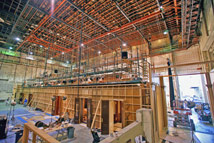|
|
|||||||||

|
||||||||||
 |
||||||||||
| Martin T. Charles of SagaBoy Productions | ||||||||||
| Recreating the Capitol for "Charlie Wilsonís War" |
||||||||||
HOLLYWOOD, CALIFORNIA - Starring Tom Hanks and Julia Roberts, the recently released movie “Charlie Wilson’s War” is based on Texas congressman Charlie Wilson’s covert dealings in Afghanistan, where his efforts to assist rebels in their war with the Soviets have some unforeseen and longreaching effects.
The story takes place in the 1980s and unfolds across continents and in U.S. legislative chambers. It has at its heart one impeccably constructed venue: the Speaker of the House Lobby of the United States Capitol. “The Capitol building is enormous and impressive, and we could not film there for various reasons including the on-location costs,” said Martin T. Charles of SagaBoy Productions, graphic designer for the Mike Nichols film. “So we had to recreate it. And since the Capitol hasn’t changed in over a hundred years, we had the sense we were recreating history. This was an interesting challenge for us.” 
|
What made it even more interesting was that art directors and designers were not allowed access to the building itself and instead had to rely on volumes of photographs to identify graphic elements and determine accurate room measurements. Multiply this task by the Speaker of the House Lobby’s 3,000-square-foot footprint, the centerpiece of which is an intricately designed 2,000-square-foot tile floor. Consider also the 2,500 running feet of wallpaper and additional ceiling art that frame the room. To wrap this interior would require thousands of feet of digitally printed graphics. For this task, Charles selected the Roland SOLJET 54” printer/cutter.
“The Speaker of the House Lobby was the visually most important graphic element in the film,” Charles said. “When you see the film, you will think that you are there at the Capitol. The as-built set was dead on to what it should have been.” Piecing together this puzzle intrigued Charles, an industry expert who has designed and produced the graphics for more than 50 feature films including Miami Vice, AI: Artificial Intelligence, Minority Report, Be Cool, 50 First Dates, Seabiscuit, Catch Me If You Can, Murder by Numbers, Stuart Little and That Thing You Do, among others. According to Charles, the 2,000-square-foot tile floor was both the most difficult and most important graphic to replicate. The process from concept to finished floor involved several steps. First, Charles reviewed photos of the actual lobby floor from the film’s library, and from these he designed the master tile pattern. |
While the Capitol interior was the dominant setting for the film, other graphic elements added style and visual interest as well. Among them, Charles cited an airplane bulkhead adorned with ancient Egyptian graphics. Using his SOLJET, he printed these intricate designs directly onto bulkhead material and wrapped the aircraft. “The results were absolutely beautiful,” he said. “This was one of my favorite graphics in the film.” Additionally, Charles and his SOLJET created all manner of political campaign graphics – from posters and murals to buttons and stationery. They also created a vintage Vegas set from the 1980s – a time and place Charles calls “very heavy on its glitter.” “We ran the SOLJET day and night for weeks,” he added. “In the end, the film had a wonderful cohesive quality. It felt like there was unity throughout all of the graphic elements.” You can view the results of Charles’ efforts in a Roland XC-540 video shot on the Paramount lot. Visit the Roland DGA video gallery. |
||||||||
|
|
||||||||||
|
A Roland DG Publication | Copyright © 2008 All rights reserved. Q1/Q2 2008 | Issue No. 5 | The Roland DG Global Network |
||||||||||